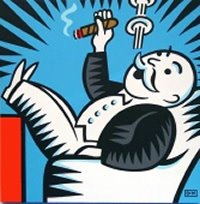 Leave it to the Murdoch Street Journal to scapegoat exactly the wrong culprit for the present mess in our markets (and it must be noted that The Eternal Molly Ivins was eerily prescient on this as noted here, concerning Long Term Capital Management; think “no oversight” and “privatizing the profit but socializing the culpability”).
Leave it to the Murdoch Street Journal to scapegoat exactly the wrong culprit for the present mess in our markets (and it must be noted that The Eternal Molly Ivins was eerily prescient on this as noted here, concerning Long Term Capital Management; think “no oversight” and “privatizing the profit but socializing the culpability”).The journal tells us the following (and calling this a “fable” is literally apropos, by the way, as opposed to reasoned analysis fit for a paper with the Journal’s alleged profile – they’re listing all of what they perceive as the milestones on our road to financial hell)…
The Community Reinvestment Act. This 1977 law compels banks to make loans to poor borrowers who often cannot repay them. Banks that failed to make enough of these loans were often held hostage by activists when they next sought some regulatory approval.To begin, here is a Wikipedia article on the Community Reinvestment Act, telling us that it is “a United States federal law that requires banks and thrifts to offer credit throughout their entire market area and prohibits them from targeting only wealthier neighborhoods with their services, a practice known as "redlining." The purpose of the CRA is to “provide credit, including home ownership opportunities to underserved populations and commercial loans to small businesses. It has been subjected to important regulatory revisions.”
Robert Litan, an economist at the Brookings Institution, told the Washington Post this year that banks "had to show they were making a conscious effort to make loans to subprime borrowers." The much-maligned Phil Gramm fought to limit these CRA requirements in the 1990s, albeit to little effect and much political jeering.
(By the way, “redlining” can take many forms, whether we’re talking about denial to jobs, health care, banks, or even supermarkets, with poor of different races and ethnicities losing out at the expense of a more well-to-do clientele, but for our purposes, we’re talking about mortgage discrimination for the moment.)
In 1995, the CRA was strengthened by President Clinton “to meet community credit needs,” and it provided for a period of review in 2002; this coincided with the founding of lenders such as Countrywide that did not mitigate loan risks with savings deposits as traditional banks did. And as a result of the “review” under Bushco, Fannie Mae and Freddie Mac – the two primary agents guaranteeing subprime loans – were moved under the Treasury Department, with Representative Mel Watt (D-NC) calling it “a shell game…(that) weaken(ed) the bargaining power of poorer families and their ability to get affordable housing.”
So it’s easy to see why the Journal and their ideological fellow travelers would despise the CRA, since it helped to level the playing field in the matter of affordable housing for all. And as far as Phil Gramm “(fighting) to limit the CRA requirements” (here)…
As a member of the Senate Finance Committee and the recipient of enormous banking contributions, Gramm did an even bigger favor for the financial industry in 1999 when he sponsored the Financial Services Modernization Act allowing banks, securities firms, and insurance companies to combine. The bill weakened the Community Reinvestment Act, which requires banks to help meet the credit needs of low- and moderate-income neighborhoods. Gramm described community groups that use the CRA as “protection rackets” that extort funds from the poor, powerless banks. The bill is also a disaster for the privacy of bank customers and weakens regulatory supervision. As Gramm proudly declared, “You’re not going to find a single bank, insurance company, or securities company that will say they were hurt financially by this bill.”Of course, no word on how consumers fared, since that constituency is invisible to Gramm anyway.
And returning to Wikipedia for a moment…
Critics claim that government policy encouraged risky lending[7] and the development of the subprime debacle through legislation like the CRA.This tells us about HR 1960, introduced in the House last year to amend the CRA in order to make housing more affordable for our veterans (probably something that should have been scheduled for debate by now). And this post from Rick Perlstein tells us, among other things, “that CRA-covered institutions tended to practice less risky lending, not more risky lending.”
…
Robert Gordon of the Center for American Progress disagrees, and quotes statistics that he claims show "independent mortgage companies, which are not covered by CRA, made high-priced loans at more than twice the rate of the banks and thrifts." He faults then-Federal Reserve chair Alan Greenspan for "cheering the subprime boom" in the banking industry.
The Journal concludes by telling us to “beware politicians who peddle fables that cast themselves as the heroes.” To that, I would only add – particularly in the case of Phil “Nation Of Whiners/Mental Recession” Gramm – that we should beware of newspapers trying to do the same thing.
(And by the way, for more posts, please click here.)
No comments:
Post a Comment